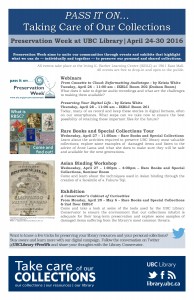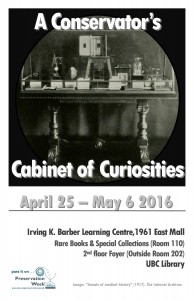Pass it on… Taking Care of Our Collections – Preservation Week 2016 – April 24th to April 30th
Preservation Week aims to unite our communities through events and exhibits that highlight what we can do – individually and together – to preserve our personal and shared collections and its sponsored by the American Library Association. Check out some of the activities we will be having this year!
Information campaign
Want to know a few tricks for preserving your library resources and your personal collections? Stay aware and learn more with our digital campaign. Follow the conversation on Twitter and share your thoughts with the Library Conservator.
This activity is open to the public.
Webinars
UBC Library will present two webinars sponsored by the Association for Library Collections & Technical Services related to the preservation of special media. Join us and ask the presenter questions!
Tuesday, April 26 – 11:00 am – IKBLC Room 302 (Dodson Room)
From Cassette to Cloud: Reformatting Audiotape – Webinar – by Krista White
Oral histories can provide a wealth of information about individual and community life. These recordings are highly prized by historians and archivists, but also by the families and communities of the persons telling their stories.
What does it take to digitize audio recordings and what are the challenges to making them available?
Thursday, April 28 – 11:00 am – IKBLC Room 261
“Preserving Your Digital Life” – Webinar – by Krista White
Our stories as individuals and as members of a community are preserved in each of our homes, in our family histories, and in life stories—not just in libraries, archives, and museums. Today, many of us record and keep these stories in digital formats, often on our smartphones.
What steps can we take now to ensure the best possibility of retaining these important files into the future?
These activities are open to the public.
Exhibition
Monday, April 24 to Friday, May 6– 2nd floor IKBLC & Rare Books and Special Collections
“A Conservator’s Cabinet of Curiosities”
Because we can’t get enough silverfish; come and take a look at some of the tools used by the UBC Library Conservator to ensure the environment where our collections inhabit is adequate for their long-term preservation and explore some samples of damaged items suffering from the libraries most common threats.
This activity is open to the public.
Rare Books and Special Collections Tour
Wednesday, April 27 – 11:00am – Rare Books and Special Collections
Join Chelsea Shriver and Anne Lama, UBC Library Conservator, in a behind the scenes tour through Rare Books and Special Collections. Learn about the activities required to preserve UBC library most valuable collections; explore some examples of damaged items and listen to the advice of Anne Lama and what she does to make sure they will be safe and available for the next generations.
This activity is open to the public.
UBC Library Rare Books and Special Collections’ Disaster Preparedness Program
Earthquakes, power outages, fire, high humidity, floods, leaks, HVAC failures, pest infestations, among many other risks are some of a few threats to our collections. Because a disaster can strike at any time, it is our responsibility to be prepared to act quickly.
Even though damages caused by these events cannot be predicted, they can be reduced with a few actions. In May 2015 we started a pilot project with RBSC to complement and expand the UBC Library Collections Disaster Recovery Manual.
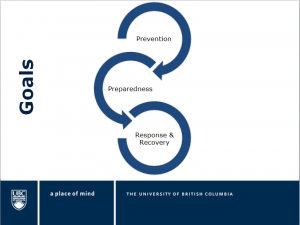 This revision includes the participation of many important agents like the library facilities coordinator and facilities manager for RBSC; the library communications and marketing director and direct consultation with RBSC personnel.
This revision includes the participation of many important agents like the library facilities coordinator and facilities manager for RBSC; the library communications and marketing director and direct consultation with RBSC personnel.
After many months of hard work, the first draft of the new plan is under revision by RBSC personnel for its implementation during 2016.
The new Collections’ Disaster Preparedness Program focuses on four stages: prevention, preparedness, response and recovery.
The Prevention Guidelines focuses on everyday tasks that can help reduce damages to collections.
- Details recommendations for the: environment, housekeeping practices, housing and shelves, functional organization, handling collections, reading room policies, security against theft, health safety, and fire and water protection.
- Includes maintenance activities and important checklists to facilitate the chores that should take place throughout the year in the library.
The Preparedness Plan prepares staff for emergency situations.
- Assigns the major responsibilities for the planning and response teams in the branch that need to take place in case of a minor or major event.
- Explains the relationship between the UBC Library Response Team and the branch response team in case of a major disaster.
- Details the communications strategy and explains the emergency supplies.
- Provides instructions and contains sensitive and personalized information related to the branch that will be needed before, during and after the emergency.
The Disaster Response and Recovery Manual explains the high level response structure for major events at UBC Library.
- Establishes the UBC Library Response Team and Disaster Response. In case of a big disaster, this structure will take over the situation to fasten decision making and library staff will be under their command.
- Describes the response and salvages procedures for the most common events in our library: water, mould, fire, earthquake and insects.
- Includes all important contacts in and out of UBC that might be needed before, during and after an emergency.
 The role of the Collections’ Disaster Preparedness Program is to provide a holistic approach to disaster
The role of the Collections’ Disaster Preparedness Program is to provide a holistic approach to disaster 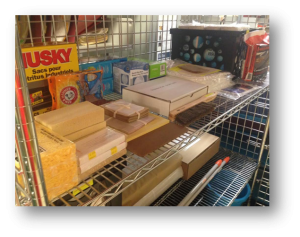 prevention and management.
prevention and management.
Besides the development of the supportive documents, the Preservation Unit: acquired supplies for collection recovery; and will provide special training for the use of supplies and hands on workshops for collection recovery.
In accordance with UBC Library Strategic Plan 2015/17 to “Build Excellence in Collections” and “ensure the long-term preservation of print and digital collections” during 2016, RBSC pilot project will be evaluated and tested with the intention to expand the efforts for collection care to all UBC Library branches.
Stay tune for more information about this project.
Preservation Week 2015
Pass it on…”A Papal Bull”: Making accessible a 770 years old document
Last week from Monday, April 27th until Friday, May 1st we celebrate Preservation Week at UBC Library, dedicating it to a behind the scenes tour around the work performed on the Privilegium Innocentii IV Pro Monasterio San Michaelis de Tridento. A manuscript dated from 1245 and issued by Pope Innocent IV at the First Council of Lyon, which confirms the privileges and property of the monastery of San Michele in Trento, Italy.
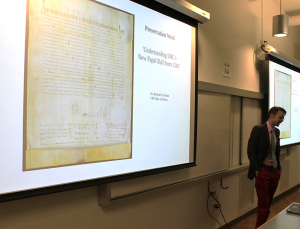 On Monday, we had the opportunity to learn about the history behind the creation of the document and its importance for UBC community from Dr. Richard Pollard and Anne Lama, UBC Library Conservator took us through the restoration of the Papal Bull.
On Monday, we had the opportunity to learn about the history behind the creation of the document and its importance for UBC community from Dr. Richard Pollard and Anne Lama, UBC Library Conservator took us through the restoration of the Papal Bull.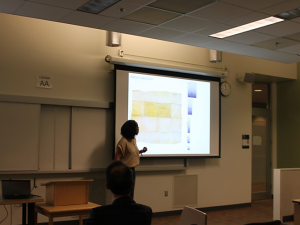
On Wednesday Susan Andrews, UBC Library cataloguer, explained all the elements needed for cataloguing this particular manuscript and on Friday, Robert Stibravy, Digital Projects Librarian at UBC, described the tools and digitization process to make accessible the Papal Bull through the library catalogue.
Also, Richard Pollard and SLAIS student Robert Makinson curated the exhibition Papal Parchments and Blackletter Books, 1245 AD to UBC: How the Middle Ages Shaped the Way we Read for Rare Books and Special Collections where the Bull is been exhibited until May 31st.
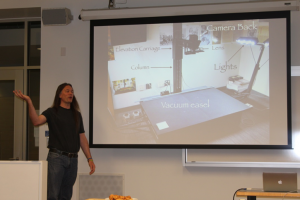 Preservation Week also dedicated some time to work promoting preservation of collections. This year we visited University Hill Elementary School. 24 students of third grade had the opportunity to learn about preservation through the construction of a BigBook.
Preservation Week also dedicated some time to work promoting preservation of collections. This year we visited University Hill Elementary School. 24 students of third grade had the opportunity to learn about preservation through the construction of a BigBook. 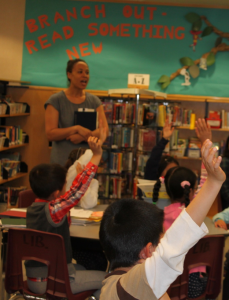 Their work was donated to the school library so others students also could learn about preserving their school collections.
Their work was donated to the school library so others students also could learn about preserving their school collections.
Also, we received a visit of 37 students of 11th grade French Immersion group from the Vancouver Technical Secondary School to learn about preserving a Papal Bull, parchment and seals. They visited RBSC, created a facsimile of a sealed charter and explored letter decoration.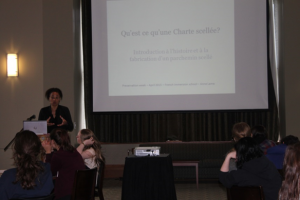
To end Preservation Week, we offered a workshop for the UBC library staff.
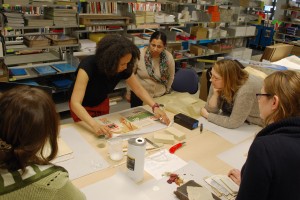 We had 5 participants and a student who brought a beloved treasure they owned to learn about basic preservation and ideas of how to take care of it at home. They cleaned the materials, repaired some tears, and learned how to create a window mat and a portfolio for protecting the objects.
We had 5 participants and a student who brought a beloved treasure they owned to learn about basic preservation and ideas of how to take care of it at home. They cleaned the materials, repaired some tears, and learned how to create a window mat and a portfolio for protecting the objects.
Restoration of a “Papal Bull”
During the month of November 2014, Anne Lama, Conservator at UBC Library, worked on the restoration of this precious document.
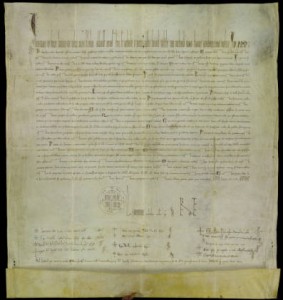
Thanks to her work the Papal Bull will be available for consultation at Rare Books and Special Collections in UBC.
If you would to view more of this process, you can visit UBC’s Flickr Site to find out about it, read the presentation of the project and you can take a look at the digitized version of the document at UBC’s Digital Collections .
Highlights:
- The “Privilegium Innocentii IV pro monasterio S.Michaelis de Tridento” dated from 1245 and issued by Pope Innocent IV at the First Council of Lyon, confirms the privileges and property of the monastery of San Michele in Trento, Italy.
- The parchment was dusty, yellow, with mold and stains.
- Also, because of the way it was stored, it suffered from deformation, dryness, lacunas and tears, folds and wrinkles.
The conservation and restoration work consisted of:
- Cleaning
- Rehydration and relaxation
- Drying and flattening
- Gaps Filling
- Housing
- Recommendations for handling
For more information you can read this article published by UBC.
Dorothy Burnett’s Book Binding Tools Exhibition
 The exhibition will be available to all public from November 2014 to April 2015 at the Rare Books and Special Collections Library.
The exhibition will be available to all public from November 2014 to April 2015 at the Rare Books and Special Collections Library.
Highlights:
- The book binding tools were donated to the RBSC by Donald Fleming.
- The collection is composed of 224 bookbinding tools, ranging in age from 60 years old to 100 years old, used by Dorothy Burnett.
- You can learn more about this tools by visiting the dedicated site at UBC Library Digital Collection: Dorothy Burnett Book Binding Tools
Biography
Dorothy Burnett graduated from Crofton House School in Vancouver and went on to study at the Vancouver School of Decorative and Applied Arts (Now Emily Carr University of Art and Design) in 1930. She taught from 1935 to 1936 after receiving a teaching certificate from the Provincial Normal School and then went on to study at the Ontario College of Art in Toronto and the California College of Arts and Crafts in Oakland. During this period, she exhibited at the Schaeffer School of Art in San Francisco in 1935, at multiple exhibitions in Vancouver from 1936-1938 and was the leading Canadian contributor to the Golden Gate International Exposition in 1939.
In 1939, Burnett became one of the first independent artisan bookbinders in Vancouver to set up a shop dedicated solely to bookbinding. She opened Craft Center Studio in the top floor of the Imperial Bank Building at Dunsmir and Granville in studio space she shared with Frances Gatewood, a classmate from her time at the Vancouver School of Decorative and Applied Arts.
In 1942, Dorothy closed her shop and two years later resumed her work in her family’s Vancouver home. Despite losing her studio, she continued to operate professionally as a bookbinder and was an active member of many bookbinding organizations, speaking on and being interviewed about bookbinding.
In 1967, having lost both her parents and suffering herself from muscular dystrophy, Dorothy moved to the Arbutus Private Hospital and Lodge. She continued to speak about and be involved with bookbinding. Her last major public showing was her contribution of Japanese Fairy Tales (bound in 1936) to an exhibition of modern bookbinding at the Art Gallery of Hamilton in 1982. She passed away in 1992.
Philosophy and Style
Dorothy Burnett was a hand bookbinder. True to the artisanal tradition, each of her books is a meticulously handcrafted and unique object.
Burnett’s approach to bookbinding differed from that of the European tradition in which books were bound in the style of, and as a reflection of, their owner. Instead, she believed the purpose of bookbinding was to capture the essence of the book being bound.
Dorothy is usually associated with the Arts and Crafts movement, a movement that rejected mass-production and automation. The movement drew inspiration from medieval and folk styles of decoration, using simple forms, themes and colours taken from nature, especially that of the English countryside. It is characterized by muted colours, especially earth tones, and a low contrast palette. While her process and much of her colour choices are indicative of the Arts and Crafts movement, her gilded motifs and pictorial representations, often composed of only a few curved lines, are suggestive of influences of the bold lines and geometric shapes of the Art Deco movement.
In comparison to other bookbinders of her time, Burnett’s bookbinding style appears, at first, conservative. She did not experiment with different leather or other binding materials such as linen, nor did she experiment with high contrast marbled endpapers, both of which were characteristic of contemporaries. Instead, she used dyed Moroccan leather, gilt top edges and untrimmed fore-edges and muted marble endpapers and box covers. The evolution of and development of her personal style took the form of gilt stylized forms, the use of differing typefaces, and the subtle relationships between colours of leather, marbled paper and headbands.
